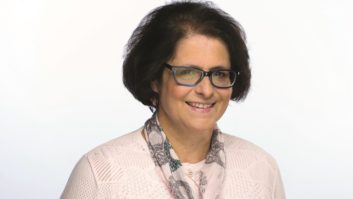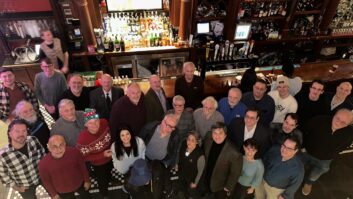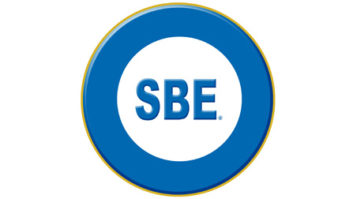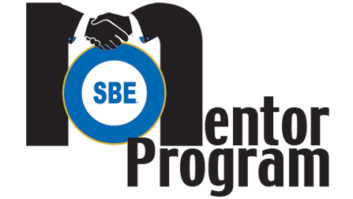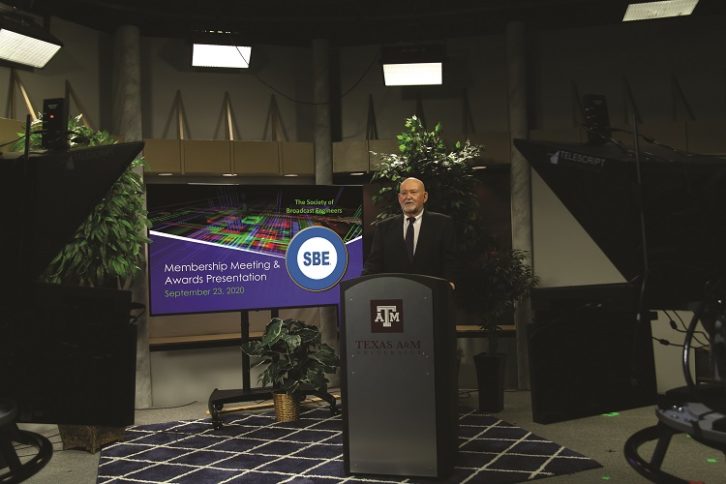
The Society of Broadcast Engineers has an incoming executive director, a new website and a pending new technical training program, among other notable changes.
Radio World caught up with Wayne Pecena, recently elected to a second term as president of SBE, to ask him about its priorities in coming months.
The non-profit society is based in Indianapolis, Ind. Pecena is associate director of educational broadcast services at Texas A&M University, which operates the KAMU(FM/TV) public broadcast stations. Appropriately for an SBE leader, he has a lengthy string of certifications including CPBE, 8-VSB, AMD, DRB and CBNE; and he is a past recipient of the Radio World Excellence in Engineering Award.
Upon reelection, Pecena noted that the industry and broadcast engineers “have experienced change and challenge like never before. I want to ensure the society brings a sense of normalcy to our members,” through its professional development continuing education, certification and frequency coordination programs.
This conversation includes reference to the pending retirement of John Poray, SBE’s first and only full-time executive director since 1992. James Ragsdale, a former finance executive at Anderson University in Indiana, will succeed Poray in January.
Radio World: This has been a year like no other. Has there been an effect on the society’s activities?
Wayne Pecena: Certainly we have been impacted, while at the same time many things are normal.
The SBE office has remained open throughout the pandemic — granted, in a modified form, observing the restrictions placed by the state of Indiana and the city of Indianapolis. But the office is open and functioning, with all programs ongoing.
We’d been doing webinars for some time. Like a lot of organizations, we were already in that virtual environment, so it wasn’t necessary to hurry and ramp up. But certainly we have increased that.
We have seen phenomenal engagement from our members in the webinars. As of last month we had twice as many participants as the year before, and we haven’t gotten to the end of the year yet.
Obviously our in-person events have been canceled, whether it’s an SBE-only event or related ones — the NAB Show being the biggie that a lot of our in-person outreach is centered around.
Many of our local chapters have gone to a virtual meeting environment. That’s a blessing and a curse, in some ways; everyone probably prefers that in-person fellowship and networking at a chapter meeting. But [we’ve seen] increased attendance in some larger areas where it’s just not easy to get across town to a 7 p.m. chapter meeting; that travel can be significant.
I know I have enjoyed attending many local chapter meetings because of Zoom around the country.
RW: It seems like in the last year or two, there’s been a real mushrooming of resources made available to your members.
Pecena: Since day one of the SBE, professional development, continuing education, has been a priority. And as technology changes rapidly it creates opportunity for further programs.
Even before the COVID pandemic, we had been aggressively ramping up, particularly, our webinar programs. Those have been most popular with our members. You can attend at a prescribed date and time for that live presentation, but we see far more participation on-demand. Those are recorded and available to our members.
The feedback that we get from those programs is very positive.
RW: I understand you’ve got an updated IP networking series coming.
Pecena: That is just one of the webinars planned.
One of the things that we have seen, not just in IP networking, is a need for more in-depth content. There’s a limit to what you can do in a webinar session, which we try to keep to an hour to an hour and 15 minutes.
So for many topics — beginning with our RF 101 series and advanced RF series, a lot of the IP content — we’ve gone to multiple part webinars. There’s an AoIP series that, gosh, I’ve lost count of the number of parts, six to seven, maybe even eight parts.
That’s how we’re addressing more advanced topics, to have enough time to address those topics but at the same time break them into manageable chunks of time. You could offer a full-day, eight=hour seminar, but there’s not many broadcast engineers who have that kind of time to sit in front of the computer.
RW: You have a pretty big change with John Poray retiring as executive director, and Jim Ragsdale coming in. How do you feel about John leaving?
Pecena: Certainly his announcement was a surprise; at the same time it was not a surprise. From the board aspect, we knew that John was going to be retiring soon, but when that announcement came at the first of this year, it still was a shock now that we had a date in front of us.
John has been the face of SBE for 28 years. A lot of growth has occurred over that time, from the office staff that keeps everything running, to the number of programs that are offered. It’s never enjoyable to lose someone with John’s tenure and experience and of course his dedication to the society.
Early in his career, when he came to SBE, he thought he’d probably be at SBE for five years and then move on to the next step up. And here we are 28 years later and he’s still with us.
We offer John sincere thanks and congratulations for his dedication to SBE and everything that he has done. I think it’s safe to say there’s not a program offered through SBE that does not have his personal touch on it in one way or the other. He’s a very engaged leader.
I suppose if you’re going to retire, there’s probably a good time to do that: when things are pretty good. Yes, we have some challenges that the industry presents and the COVID situation has presented. But we have a society that is in sound financial shape. We have successful programs. We have a dedicated and supportive staff that takes care of all of that day-to-day stuff.
If you’re going to say goodbye to 28 years, this is probably a good time to leave, at the top of things.
RW: How did the search go and what struck you about Jim Ragsdale?
Pecena: Our response from potential candidates was a little overwhelming; I personally had felt that if we got maybe 10 applications we’re going to be good, and we had pushing 30. So then we had a different challenge in front of us. How do we weed through this?
We had a dedicated committee led by Joe Snelson, a former SBE president and [who has experience in] the corporate environment. He did a really good job in leading that effort.
We boiled things down to three candidates and engaged in face-to-face interviews in Indianapolis. The three candidates were uniquely different but all viable for the position.
Jim was chosen unanimously by the committee. He did his homework on the SBE. He brought the best perspective of looking ahead. Granted, he was from outside the industry, but at the same time, he had ties to the broadcast industry through family members who were engaged in broadcasting for many years, and he brought solid financial management strengths, particularly in a nonprofit environment, as well as solid reference evaluations from previous roles.
Everyone felt he was that right fit for SBE.
RW: What should we look for from SBE in coming months?
Pecena: I think we step back and take a new breath and give Jim Ragsdale a time to get acclimated. We have several new programs that are launching, I don’t want to remotely suggest we’re just going to stop doing things; but give Jim an opportunity to get up to speed, making his own evaluations. He brings a solid financial background and [can make] his own assessments with that.
And this is strictly a personal feeling, but we probably need to revisit our strategic planning efforts. In our last event about three years ago, we came up with a plan, and many of the aspects of that plan have been implemented. You’ve noticed the new website, for instance; the need for that was identified in that strategic plan.
What was also identified but frankly has not happened has been some of our expanded outreach activities engaging in other related organization’s activities — whether it’s a state broadcast conference or local chapter events. Of course with the COVID situation, that kind of stuff went away.
So I think once he gets a solid footing by mid year, we need to reevaluate our strategic plan. Not necessarily do it all over again, though maybe that’s the best way to do it. In today’s fast changing environment. I’m not sure doing strategic planning every five years is the right time. Maybe it should be shortened a little bit.
Our focus, I think, will continue to be on education certification, our frequency coordination activities that are going on. You don’t necessarily hear a lot about frequency coordination, because it’s going on in the background, but there’s a lot of work that goes into that, particularly with the Department of Defense contract that SBE is involved in.
RW: The direction of membership trends is down over time.
Pecena: Yes it is down, That was a big focus of our last strategic planning effort — ways to increase that membership, and that was the basis of our outreach program.
We still need to focus on the increasing membership.
RW: We’ve seen a lot of attention in the national discussion over diversity, and as we’ve reported, radio engineering in the United States certainly has not got a lot of racial diversity, or age diversity for that matter. What role, if any, does the SBE have in this discussion?
Pecena: That is an aspect that needs to be on our radar. I’ll just say, it honestly has not been a dedicated focus. We have been focused more broadly on increasing our membership by providing desirable, needed services to our members regardless of race or demographic background. I think we have some more fundamental things to work on before we dedicate our resources to a specific area. That’s my personal feeling.
We are working too on revamping our international program, with a new committee chair who is going to take a look at that aspect; that brings more of an international perspective.
RW: SBE has always kept a voice on Capitol Hill when there are technical issues being discussed. Are there things that SBE is following closely in Washington that we should know about?
Pecena: Certainly I think that “spectrum grabs” will continue, and we continue to comment.
When the December SBE Signal newsletter comes out, there’ll be a piece that Chris Imlay wrote regarding some actions questioning the ethics of broadcast engineers in general. I think he’s done a really good job of responding to that.
We’ll continue to do our best to help the SBE make good decisions. A lot of times decisions are made without the true technology impact [being considered]. We’ll do our best to keep our opinions in front of those FCC staffers.
RW: The 2021 calendar already looks different with no spring NAB Show. How are your events and meetings affected?
Pecena: Historically the SBE has two major in-person events a year, the first centered around the NAB in the spring, and then the national meeting, which occurs in the fall, typically in conjunction with a regional broadcasting event. This year it was to be Chapter 22’s Broadcast and Technology Expo in Syracuse, N.Y.
With everything shuffling around and the NAB moving to an October show next year, it was not felt we could do both of those within three weeks; so the 2021 NAB will feature our traditional “NAB events” with that national meeting and awards presentation, which of course this year were done virtually.
It looks good on paper today. We’ll see how things work out.
Everyone is hopeful that we can get back to some in-person events at some point. One of the things we’re always excited to do is our regional Ennes workshops. Outside of one early this year, they were all canceled, so I’m hopeful that at some point in 2021, we can get back to those in-person regional Ennes workshops around the country. We have several chapters or state broadcast associations that are interested in that.





